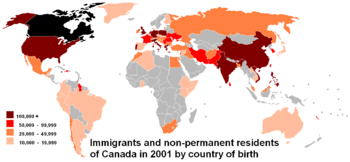Canada's province of Nova Scotia has introduced a new immigration programme called Nova Scotia Demand: Express Entry which gives migrants the opportunity to settle down in Canada even without a job offer at hand. The province has set to accommodate 350 applications for this year.
REUTERS/Chris Wattie
Canada's Employment Minister Jason Kenney (R) speaks during a news conference with Immigration Minister Chris Alexander in Ottawa June 20 , 2014. REUTERS/Chris Wattie
Canada's Employment Minister Jason Kenney (R) speaks during a news conference with Immigration Minister Chris Alexander in Ottawa June 20 , 2014. REUTERS/Chris Wattie
But while a job offer is not a requirement, Canada Immigration points out that an applicant still needs to adhere to a point-based system, where s/he must have a minimum of 67 points out of 100 to be eligible for application. The programme is available to individuals along with their spouse or common-law partner as well as dependent children under 19 years old.
Each applicant will be assessed based on a points grid that measures education, language ability, work experience, age and adaptability factors. The potential candidate will also be evaluated if s/he already has an arranged job offer from a Nova Scotia-based employer.
Before one can apply, s/he must have had at least one year of full-time or equivalent part-time work experience in one of the 29 skilled opportunity occupations considered in-demand within the past five years. Such opportunity occupations include various professions in the engineering, science, healthcare, finance and computing industries.
Language ability in English or French will be assessed and will be subjected to a minimum score in a test recognised by the government of Canada. It could either be the IELTS or CELPIP for English or TEF for French. The applicant is highly advised to attain at least Canadian Language Benchmark (CLB) seven in one of these tests. Nova Scotia may also require a foreign diploma, certificate or credential if a candidate does not have a post-secondary Canadian educational credential.
Potential candidates to the Nova Scotia Demand: Express Entry have two application routes, either:
§ apply directly to the Nova Scotia Office of Immigration (NSOI) and then enter the Express Entry pool with a provincial nomination, which will trigger an invitation to apply for permanent residence; or
§ be selected from the Express Entry pool by the NSOI.
Nova Scotia has at least three types of immigration programmes: The Nova Scotia Demand: Express Entry programme; the Skilled worker programme; and, the Family Business Worker programme. Nova Scotia is forecast to have the third-highest level of economic growth of all Canadian provinces in 2015.
Source: http://au.ibtimes.com/articles/579199/20150115/canada-nova-scotia-immigration.htm#.VLkm3yvF-So
































